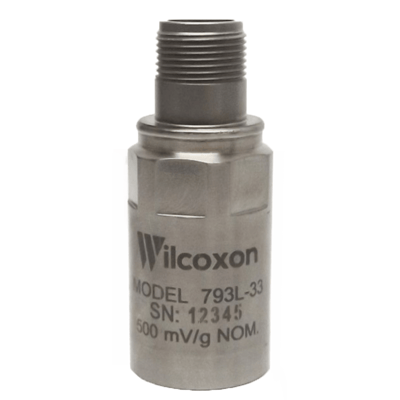Description
Low-frequency measurements for condition monitoring can present some of the biggest challenges for vibration detection. Applications typically include slow-speed agitators, wind turbines, cooling towers, semiconductor lithography, and seismic monitoring. Low-frequency measurements and low levels of acceleration are closely related, making the electronic circuitry critical to obtaining a good measurement. In order to have adequate voltage levels with high signal-to-noise ratio at the acquisition equipment, low-frequency accelerometers must have sensing elements with higher output than general-purpose sensors. The low-end frequency cutoff of the amplifier is designed to offer clear signals down to < 0.1 Hz.
The 793L sensor is available classified by various testing agencies for usage where ignitable concentrations of flammable gases, vapors or liquids are present continuously under normal operating conditions. for proper protection the installation drawing must be followed.
Features- High sensitivity
- Ultra low-noise electronics for clear signals at low vibration levels
- Low pass filtered to attenuate high frequencies
- Hermetically sealed
- ESD-protected
- Reverse wiring protection
- Manufactured in an approved ISO 9001 facility
Specifications
Specifications
Approvals & Certifications
- CE
- CSA Class I, Div. 1, Grade A, B, C, D
- FM Class I, Div. 1, Grade A, B, C, D, E, F, G, Class I, Div. 2, Grade A, B, C, D, F, G, Class I, Div. 3
Approvals & Certifications
- ISO 9001
Circuit Protection
- ESD Protection
- Reverse Wiring Protection
Electrical Connectors
- Cable (J9T2A)
- Mating Connector: R6 Typical
- Output Connector: 2-Pin, MIL-C-5015 Style
Element
- Sensing Element Design: PZT, Compression
Enclosure, Body Material
- 316L Stainless Steel
Frequency
- Frequency Response (-10 %): 0.4 to 1,000 Hz
- Frequency Response (-3 dB): 0.2 to 2,300 Hz
- Frequency Response (-5 %): 0.6 to 700 Hz
- Resonance Frequency: 15 kHz
Mounting
- 1/4-28 Tapped Hole
Noise
- Electrical Noise, Equivalent G, Nominal (Broadband: 2.5 Hz to 25 kHz): 8.0 µg
- Electrical Noise, Equivalent G, Nominal (Spectral: 1,000 Hz): 0.2 µg/√Hz
- Electrical Noise, Equivalent G, Nominal (Spectral: 100 Hz): 0.4 µg/√Hz
- Electrical Noise, Equivalent G, Nominal (Spectral: 2 Hz): 2.0 µg/√Hz
Non-Linearity
- Amplitude Non-Linearity: 1 %
Output Impedence
- Maximum 100 Ω
Power Requirement
- 18-30 Vdc
- Current Regulating Diode: 2-10 mA
Range
- Acceleration Range: 10 G Peak
Seal Type
- Hermetic
Sensitivity
- Base Strain Sensitivity, Max.
- Sensitivity, ± 5 %, 25° C (77° F): 500 mV/g
- Transverse Sensitivity: Max. 5 % of axial
Shock
- Shock Limit: 5,000 G Peak
Temperature Range
- -50° to 120° C (-58° to 248° F)
Vibration
- Vibration Limit: 250 G Peak
Voltage
- Bias Output Voltage: 10 Vdc
